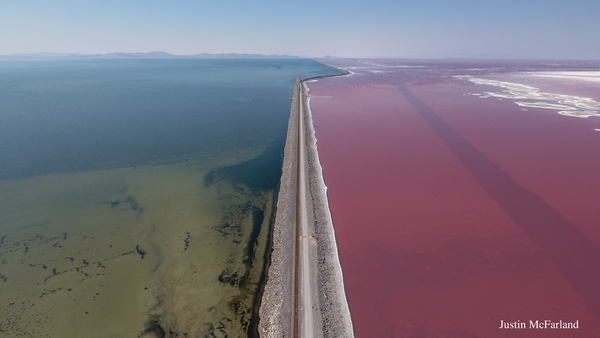Dublin Core
Title
Description
Utah’s Great Salt Lake is a remnant of ancient Lake Bonneville. Today, it is the largest saline lake in the western hemisphere and keystone to the ecosystem of northern Utah. Human attempts to dominate its massive waters have radically changed its appearance and ecology. The shrinking lake is Utah’s canary in the coalmine – drying up right before our eyes as climate change begins to affect our home.
Trouble began for our inland sea in 1904 when the Union Pacific Railroad constructed a twelve-mile wooden causeway between the lake’s western shore and Promontory Point. The trestle, called the Lucin Cutoff, used wood from almost 40,000 trees – enough for a two-square-mile forest. Eventually it was replaced by a stone earthen fill causeway, which blocked the water flow to the lake’s north arm, effectively creating two ecosystems. Now, the North arm is pink in color because increased salinity allows halophilic bacteria to flourish. The less salty south remains a blue-green.
While the lake’s surface level fluctuates naturally, the general trend since 1847 is downward and today hovers near an all-time historic low, exposing around 550 square miles of lake bed. The primary cause is water diversions on its tributaries, as the Bear, Weber, and Jordan Rivers are siphoned off to support Utah’s growing population. As a terminal lake, anaerobic bacteria from our run-off builds up poisonous mercury, affecting the migratory birds that frequent its shores from as far away as Mexico and Russia. On top of this, the decreased water levels have left islands high and dry, making nesting birds vulnerable to overland predators.
What is the future of our inland sea? As the lake shrinks, environmental issues are starting to appear. Its vast waters have long moderated temperatures and increased precipitation along the Wasatch Mountains. But now, exposed mudflats are contributing to toxic dust in the air we breathe. Our breath, our health, and even some of our key economic industries are threatened by a shrinking Great Salt Lake. With the widespread impacts of climate change increasingly apparent, it is hard to look away from the water management crisis manifesting in our own backyard.
Creator
Source
Image: The Lucin Cutoff Causeway splits Great Salt Lake in two and impacts water flow to the lake's north end. The resulting increase in salinity causes halophilic bacteria to flourish and turns the water pink. The less salty south remains a blue-green. The causeway was an engineering dream but became a nightmare as it sank fifteen feet into the lake’s bed, further blocking water flow between the two halves. Attempts to breach the causeway have been less than successful. Image courtesy Justin MacFarland.
_______________
See Gregory E. Smoak, Utah's Water Ways (Utah Humanities, 2020); Frederick M. Huchel “The Lucin Cutoff,” Utah History to Go: History of Box Elder County, accessed January 2021; “Striking a Balance on the Great Salt Lake,” Union Pacific: Inside Track, last modified June 14, 2016; “The Great Salt Lake,” U.S. Department of Interior/U.S. Geological Survey (U.S. Government Printing Office, 1991); Emma Penrod, “Breach may help solve toxic mystery in Great Salt Lake,” Salt Lake Tribune, last modified June 5, 2017.

